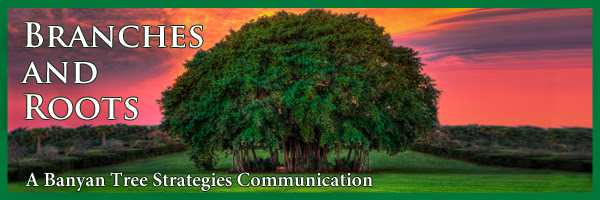|
"Branches & Roots": A Look at Strategy and Competition Through the Lens of Business and Sport A Banyan Tree Strategies Communication Don't Forget the Followers If stimulation and activity can make a day pass more quickly, than it stands to reason that the first 45 days of 2016 have been a blur. The world is in play, the start of the year has most groups advancing their agendas, and it would appear some decade old economic plates are shifting. This combined with the fact that you have a super computer on your person at all times can make us feel compelled to be up to speed with everything, the consequences can lead to feeling busy but getting nowhere. Fortunately with the right technology and some personal awareness, we can set up filters to maintain our productivity and make the best contribution possible. Several ideas and conversation threads began to emerge from our meetings and we would like to share with you our findings, and when you have a minute we would appreciate your comments and educated perspective. We start by looking at the strength of having a common mission when it comes to helping disparate groups come together for success. A different set of meetings had us looking more closely at what it takes to be a good follower, and we close by asking you how long it takes your team to deal with conflict. Keep the Lava Flowing Take the business or effort that you are most committed to and think how long it would it would last if you left it unattended. Would your business last one day, one week, one month, or longer if you stopped calling on your customers? Could your customer get the service or product you provide someplace else? Given the maturity of most of our markets and the competitive landscape the answer can be quite short. We have used this example in several settings to help leaders share with their constituents and team members just how diligently we must care for our causes. An image that appears to accompany this thought nicely is that of an island in the middle of the ocean. As long as the lava is flowing the island is growing, once it stops the ocean starts to win the battle and eventually the island is gone. In our metaphor the lava is the idea that binds and gives life to the effort. As time marches forward many people lose sight of the idea, and assume that the lava will always flow. Into this setting a simple question might be of use to you. What is the mission? Without the proper gravity applied to the situation, answers to what is the mission will favor the flippant and glib, so be sure to lay the correct foundation. Then sit back and listen to all parties, and hone in on the common elements that can be agreed on to keep the lava flowing. Teams come in all shapes, sizes, and styles in how they succeed, yet most have a common mission or idea that they sell both inside and outside the organization. If you are a leader of any type, we are curious what you will hear when you ask, what is the mission? Good Followers Make Good Leaders It is hard to go five minutes in America today and not hear about the need for better leaders. Most organizations are consistently messaging how they will help you become a better leader, and the word management has become the anti-thesis to leadership. Yet to lead anyone other than yourself you actually need someone else to commit to following you. On that topic we have read, seen, or heard very little. Why is this? Should you care about it? How might it benefit you to be able to follow and lead as the situation fits? The lack of attention with following might be tied to the disruption that software and long tail businesses have been having on the established norms in the past few decades. Yet disruption by technology easily goes back to the time of Martin Luther and the Gutenberg press (Clay Shirky’s Ted Talk is a good example). It turns out humans grow tired of being forced to follow leaders and companies that gain an advantage and then force it upon the world. Freedom of choice and free will are glorious, and technology is affording many the chance to lead themselves. Yet eventually we do have some plumbing and infrastructure issues that require group cohesion, and we get back to the notion of following. Pick a group situation like a youth sports team 16 weeks in duration, or your current employer, or your city's recreation and parks department. Without a clear plan for leading and following, chaos reigns. It is here where we offer some insights for you to consider and hopefully comment. A member of the team, company, or town might be thinking they have customer rights as if they are staying at a Ritz Carlton hotel. We have found it can be healthier if they embody the spirit of a Salvation Army bell ringer at Christmas time, asking, how might I help the team today, and what can I do to make this a better team environment? Key traits we have noticed in all-star followers are empathy, foresight, and encouragement. What happens to us when we are tasked with following is we go through a process of seeing the needs of those around us, and learning how to keep thinking while someone else is in command. What you are thinking about is key for you to then train those who follow you when your turn comes to lead. We close this thought with a hope that you will see the benefits of following as a pathway to leading others more effectively in the future. Seek to make those around you better, understand the groups needs and advance the common cause and soon enough you will have more responsibility. At that point you may look around you and wish that you had been a better follower, who could now teach others what to do so you could focus on your role as leader. How Big is Your Conversational Graveyard? All of us have a conversation or two that we have held off having because the cost benefit analysis did not add up in our mind. Any group of people who assemble will eventually have a misalignment of goals and conflict and emotion will enter the room. It is at this moment that our graveyard grows, or we address the issue and move forward more equipped to tackle the next conflict as a unit. Think about your own graveyard at work or at home, is yours bursting at the seams? Recently the team at Vital Smarts shared a video where they declared the health of an organization could be tied directly to the length of time it takes them to address conflicts. Part of the reason we all have a graveyard is that emotion is one of hardest things for our body to process, and we decide that it is safer to bury it. The challenge is that conflicts don’t dissolve, they fester. Situations arise where the old emotions reappear in an instant, and then everyone around you sits back to watch you squirm, or better yet give them a front row seat to a fireworks show. Building a conversational tool kit to manage these conflicts is one of the most empowering and career advancing things you can do for your team. It will also save your team hundreds of hours that aren’t wasted with people talking about the latest battle, or from people working at half speed dealing with the emotions in their heads. So look at your own conversational graveyard, and think about the story that is in your head with respect to the other party. Consider setting a goal of addressing it in the next week. Like a big project that is finished, a conflict resolved can be one of the most re-energizing feelings in the world, if you want some help, give us a call and we will share some tips we have learned that make tough conversations a little easier. Thanks for collaborating with us and sharing your thoughts on these topics here, and we will see you at the beginning of April.
0 Comments
|
Archives
November 2023
Categories
All
Complete Annual Newsletter Volumes
|



